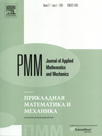 | | Journal of Applied
Mathematics and Mechanics
Russian Academy of Sciences | | Founded
in January 1936
(Translated from 1958)
Issued 6 times a year
ISSN 0021-8928
(print version) |
Archive of Issues
| Total articles in the database: | | 10610 |
| In Russian (ΟΜΜ): | | 9811
|
| In English (J. Appl. Math. Mech.): | | 799 |
|
| << Previous article | Volume 76, Issue 5 / 2012 | Next article >> |
| A.V. Kolomiyets-Romanenko and V.N. Kukudzhanov, "Damage and rupture of thick homogeneous and double-layer plates due to bending under a rigid punch," J. Appl. Math. Mech. 76 (5), 547-551 (2012) |
| Year |
2012 |
Volume |
76 |
Issue |
5 |
Pages |
547-551 |
| Title |
Damage and rupture of thick homogeneous and double-layer plates due to bending under a rigid punch |
| Author(s) |
A.V. Kolomiyets-Romanenko (Moscow, Russia, kolomiets@ipmnet.ru)
V.N. Kukudzhanov (Moscow, Russia, kukudz@ipmnet.ru) |
| Abstract |
Numerical modelling of the process of rheological loss of stability and localization of plastic deformations with the formation of a strip of adiabatic shear and extension when homogeneous plates are bent (a plane strain state) under the action of a rigid punch is carried out. Models of an ideally elastic-plastic medium and of an elastic-plastic medium are considered, taking into account nucleation and the growth of pores. The formation of strips of localization of plastic deformations in homogeneous freely supported plates is considered for different conditions of contact interaction between the sample, the punch and the supports. The mechanism of the formation of strips of localization in regions where the material is stretched by the punch is determined. By comparing the behaviour of an ideally elastic-plastic and porous plate for different friction coefficients in the contact area it is shown that external friction leads to a considerable increase in the porosity and softening of the damaged material; for an ideally elastic-plastic material the effect of friction on the limiting load is small. In a freely supported plate, the porosity is localized in the lowest fibres in the region under the punch, while in the upper layers, where the material suffers compression, it behaves as an ideally elastic-plastic material. When the boundary conditions on the rigid clamping at the ends of the plate are changed for large bendings, longitudinal stretching of the plate occurs. Strips of pore localization are formed around the rigid clamps over the whole plate thickness, which leads to a loss of load-carrying capability. The process of rheological loss of stability, softening and plastic strain localization is investigated based on continuum modelling of the rupture. |
| Received |
12 April 2012 |
| Link to Fulltext |
|
| << Previous article | Volume 76, Issue 5 / 2012 | Next article >> |
|
 If you find a misprint on a webpage, please help us correct it promptly - just highlight and press Ctrl+Enter If you find a misprint on a webpage, please help us correct it promptly - just highlight and press Ctrl+Enter
|
|

 Russian
Russian  English
English